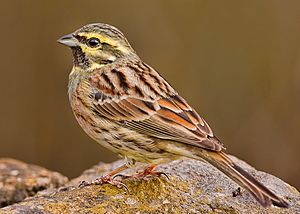Bunting (bird) facts for kids
Quick facts for kids Bunting (bird) |
|
|---|---|
 |
|
| Cirl bunting (Emberiza cirlus) | |
| Scientific classification |
|
| Kingdom: | Animalia |
| Phylum: | Chordata |
| Class: | Aves |
| Order: | Passeriformes |
| Superfamily: | Emberizoidea |
| Family: | Emberizidae Vigors, 1831 |
| Genus: | Emberiza Linnaeus, 1758 |
| Species | |
|
44, see text |
|
| Synonyms | |
|
|
Buntings are small, seed-eating birds found mainly in the Old World, which means Europe, Asia, and Africa. They belong to a group of birds called passerines, also known as perching birds. All buntings are part of the single genus called Emberiza. This genus is the only one in the bird family Emberizidae. Buntings have short, cone-shaped beaks that are perfect for cracking open seeds.
Contents
What are Buntings?
Buntings are known for their varied colors and often clear, simple songs. They live in many different places, from forests and grasslands to mountains. Most buntings eat seeds, especially in winter. In warmer months, they also enjoy eating insects. This helps them get enough protein for breeding.
Bunting Family Tree
Scientists group living things into families and genera. The family Emberizidae used to be much larger. It included birds now in other families, like the Passerellidae (New World sparrows) and Calcariidae (longspurs and snow buntings).
Scientists used DNA studies to learn more about bird relationships. These studies showed that the large Emberizidae family actually contained different groups. Because of this, these groups were then placed into their own separate families.
Naming the Buntings
The genus Emberiza is now the only one in the Emberizidae family. A Swedish scientist named Carl Linnaeus first described this genus in 1758. He wrote about it in his famous book, Systema Naturae. The yellowhammer (Emberiza citrinella) was chosen as the main example for this group. The name Emberiza comes from an old German word, Embritz, which means "bunting."
Some birds that were once in their own separate groups are now part of Emberiza. These include the crested bunting (Melophus lathami), the slaty bunting (Latouchiornis siemsseni), and the corn bunting (Miliaria calandra). All these species are now considered true buntings.
Buntings and Their Relatives
A big DNA study in 2019 looked at many passerine birds. It found that buntings are most closely related to the longspurs and snow buntings. These birds are in the family Calcariidae.
You might hear about "buntings" in the New World (the Americas). For example, the Painted Bunting is a very colorful bird. However, these birds are in a different family called Cardinalidae. They are not closely related to the Old World buntings.
List of Bunting Species
There are 44 known species of buntings in the Emberiza genus. Here are some of them:
- Crested bunting (Emberiza lathami)
- Slaty bunting (Emberiza siemsseni)
- Corn bunting (Emberiza calandra)
- Yellowhammer (Emberiza citrinella)
- Pine bunting (Emberiza leucocephalos)
- Rock bunting (Emberiza cia)
- Godlewski's bunting (Emberiza godlewskii)
- Meadow bunting (Emberiza cioides)
- White-capped bunting (Emberiza stewarti)
- Jankowski's bunting (Emberiza jankowskii)
- Grey-necked bunting (Emberiza buchanani)
- Cinereous bunting (Emberiza cineracea)
- Ortolan bunting (Emberiza hortulana)
- Cretzschmar's bunting (Emberiza caesia)
- Cirl bunting (Emberiza cirlus)
- Striolated bunting (Emberiza striolata)
- House bunting (Emberiza sahari)
- Lark-like bunting (Emberiza impetuani)
- Cinnamon-breasted bunting (Emberiza tahapisi)
- Gosling's bunting (Emberiza goslingi)
- Socotra bunting (Emberiza socotrana)
- Cape bunting (Emberiza capensis)
- Vincent's bunting (Emberiza vincenti)
- Tristram's bunting (Emberiza tristrami)
- Chestnut-eared bunting (Emberiza fucata)
- Little bunting (Emberiza pusilla)
- Yellow-browed bunting (Emberiza chrysophrys)
- Rustic bunting (Emberiza rustica)
- Yellow-throated bunting (Emberiza elegans)
- Yellow-breasted bunting (Emberiza aureola)
- Somali bunting (Emberiza poliopleura)
- Golden-breasted bunting (Emberiza flaviventris)
- Brown-rumped bunting (Emberiza affinis)
- Cabanis's bunting (Emberiza cabanisi)
- Chestnut bunting (Emberiza rutila)
- Tibetan bunting (Emberiza koslowi)
- Black-headed bunting (Emberiza melanocephala)
- Red-headed bunting (Emberiza bruniceps)
- Yellow bunting (Emberiza sulphurata)
- Black-faced bunting (Emberiza spodocephala)
- Grey bunting (Emberiza variabilis)
- Pallas's reed bunting (Emberiza pallasi)
- Japanese reed bunting (Emberiza yessoensis)
- Common reed bunting (Emberiza schoeniclus)
One species of bunting is now extinct:
- † Long-legged bunting (Emberiza alcoveri) (This bird lived a long time ago.)
See also
 In Spanish: Emberiza para niños
In Spanish: Emberiza para niños

